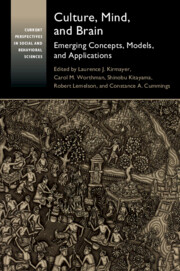Book contents
- Culture, Mind, and Brain
- Current Perspectives in Social and Behavioral Sciences
- Culture, Mind, and Brain
- Copyright page
- Dedication
- Epigraph
- Contents
- Figures
- Tables
- Contributors
- Preface
- Abbreviations
- 1 Introduction
- Part I Dynamics of Culture, Mind, and Brain
- Part II Applications
- 12 The Cultural Brain as Historical Artifact
- 13 Experience-Dependent Plasticity in the Hippocampus
- 14 Liminal Brains in Uncertain Futures
- 15 The Reward of Musical Emotions and Expectations
- 16 Literary Analysis and Weak Theories
- 17 Capturing Context Is Not Enough
- 18 Social Neuroscience in Global Mental Health
- 19 Cities, Psychosis, and Social Defeat
- 20 Internet Sociality
- 21 Neurodiversity as a Conceptual Lens and Topic of Cross-Cultural Study
- 22 Epilogue
- Index
- References
17 - Capturing Context Is Not Enough
The Embodied Impact of Story and Emotion in Ethnographic Film
from Part II - Applications
Published online by Cambridge University Press: 18 September 2020
- Culture, Mind, and Brain
- Current Perspectives in Social and Behavioral Sciences
- Culture, Mind, and Brain
- Copyright page
- Dedication
- Epigraph
- Contents
- Figures
- Tables
- Contributors
- Preface
- Abbreviations
- 1 Introduction
- Part I Dynamics of Culture, Mind, and Brain
- Part II Applications
- 12 The Cultural Brain as Historical Artifact
- 13 Experience-Dependent Plasticity in the Hippocampus
- 14 Liminal Brains in Uncertain Futures
- 15 The Reward of Musical Emotions and Expectations
- 16 Literary Analysis and Weak Theories
- 17 Capturing Context Is Not Enough
- 18 Social Neuroscience in Global Mental Health
- 19 Cities, Psychosis, and Social Defeat
- 20 Internet Sociality
- 21 Neurodiversity as a Conceptual Lens and Topic of Cross-Cultural Study
- 22 Epilogue
- Index
- References
Summary
In cultural anthropology, ethnographic film is useful for documenting diverse cultural practices and presenting research. Film’s ability to capture behavior in its holistic context is a key contribution to interests of cultural neuroscience, which has been challenged to better illustrate the impact of its findings outside the laboratory. Still, ethnographic film might go further by accounting for the interaction of culture, mind, and brain in the embodied aspects of the film experience. Neuroscientific inquiry into various storytelling genres reveals the embodied effects of storytelling, which activates neural mechanisms putatively evolved to strengthen social and cultural bonds. In this, storytelling strategy and structure are important; effective stories both engage sustained attention and elicit empathetic response. Character-driven emotional stories following a dramatic arc have greater impact than dispassionate ones. This translates directly to film, which also affords opportunities for emotional attunement and sensory-motor resonance with characters onscreen. Ethnographic film conventions have not adequately developed a methodology responsive to this nuanced understanding, despite anthropology’s long-standing investment in the power of storytelling. A “visual psychological anthropology” approach produces emotionally resonant, character-driven film stories in a dramatic narrative structure. Such films can convey cultural information and impart key concepts in a more immersive way.
- Type
- Chapter
- Information
- Culture, Mind, and BrainEmerging Concepts, Models, and Applications, pp. 426 - 437Publisher: Cambridge University PressPrint publication year: 2020



